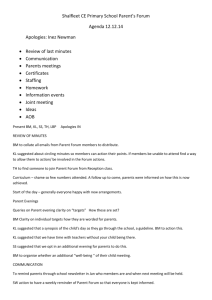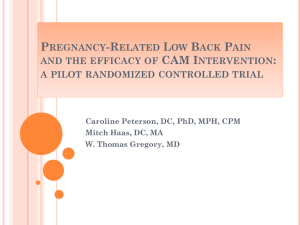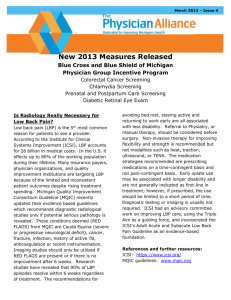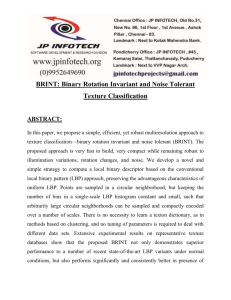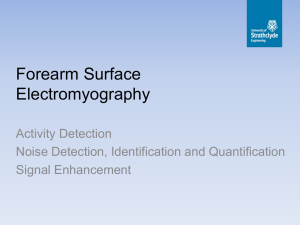View/Open - Lirias
advertisement
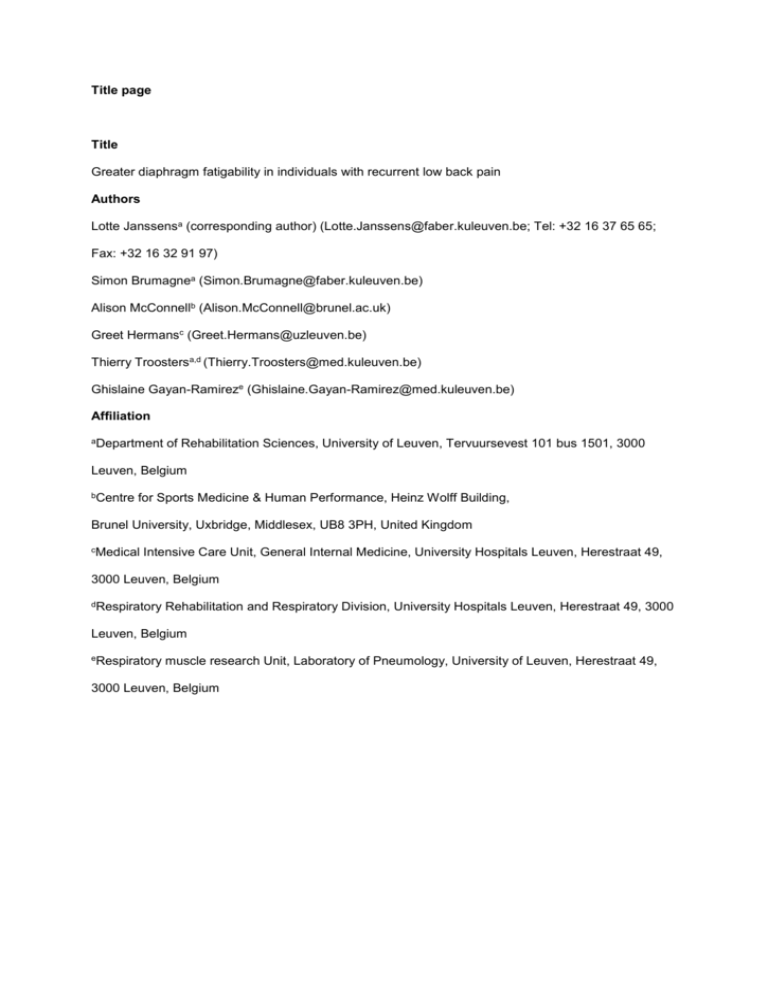
Title page Title Greater diaphragm fatigability in individuals with recurrent low back pain Authors Lotte Janssensa (corresponding author) (Lotte.Janssens@faber.kuleuven.be; Tel: +32 16 37 65 65; Fax: +32 16 32 91 97) Simon Brumagnea (Simon.Brumagne@faber.kuleuven.be) Alison McConnellb (Alison.McConnell@brunel.ac.uk) Greet Hermansc (Greet.Hermans@uzleuven.be) Thierry Troostersa,d (Thierry.Troosters@med.kuleuven.be) Ghislaine Gayan-Ramireze (Ghislaine.Gayan-Ramirez@med.kuleuven.be) Affiliation aDepartment of Rehabilitation Sciences, University of Leuven, Tervuursevest 101 bus 1501, 3000 Leuven, Belgium bCentre for Sports Medicine & Human Performance, Heinz Wolff Building, Brunel University, Uxbridge, Middlesex, UB8 3PH, United Kingdom cMedical Intensive Care Unit, General Internal Medicine, University Hospitals Leuven, Herestraat 49, 3000 Leuven, Belgium dRespiratory Rehabilitation and Respiratory Division, University Hospitals Leuven, Herestraat 49, 3000 Leuven, Belgium eRespiratory muscle research Unit, Laboratory of Pneumology, University of Leuven, Herestraat 49, 3000 Leuven, Belgium Abstract The diaphragm plays an important role in spinal control. Increased respiratory demand compromises spinal control, especially in individuals with low back pain (LBP). The objective was to determine whether individuals with LBP exhibit greater diaphragm fatigability compared to healthy controls. Transdiaphragmatic twitch pressures (TwPdi) were recorded in 10 LBP patients and 10 controls, before and 20 and 45 minutes after inspiratory muscle loading (IML). Individuals with LBP showed a significantly decreased potentiated TwPdi, 20 minutes (-20%) (p=0.002) and 45 minutes (-17%) (p=0.006) after IML. No significant decline was observed in healthy individuals, 20 minutes (-9%) (p=0.662) and 45 minutes (-5%) (p=0.972) after IML. Diaphragm fatigue (TwPdi fall ≥10%) was present in 80% (20 minutes after IML) and 70% (45 minutes after IML) of the LBP patients compared to 40% (p=0.010) and 30% (p=0.005) of the controls, respectively. Individuals with LBP exhibit propensity for diaphragm fatigue, which was not observed in controls. An association with reduced spinal control warrants further study. Key words diaphragm fatigue, phrenic nerve stimulation, postural balance, spinal control 1. Introduction Low back pain (LBP) has become a well-known health problem in the Western society (Airaksinen et al., 2006). Current treatment interventions have a relatively small effect size, since the etiology of LBP is not fully understood. Although difficult to diagnose, the phenomenon of LBP is usually dealt with as a specific and independent disorder. However, respiratory dysfunction seems to be common with LBP, suggesting that back problems may not be a distinct musculoskeletal issue (Hestbaek et al., 2004). The European guidelines reported a point-prevalence of LBP of 33% in the general population (Airaksinen et al., 2006), and there is evidence to suggest that this prevalence may be particularly high in individuals with respiratory disorders (Synnot and Williams, 2010). Interestingly, this association between LBP and disorders of breathing appears to be even stronger than its relationship with obesity and physical activity (Smith et al., 2006). However, the underlying mechanisms for this association remain poorly understood. The human diaphragm is the primary muscle involved in active inspiration. Besides its respiratory function, the diaphragm also plays an important role in stabilising the spine during balancing and loading tasks (Hodges and Gandevia, 2000). We have recently shown that an increased demand on one of its functions (an inspiratory loading task) will inevitably abolish the other function, in terms of impaired balance control (Janssens et al., 2010). Healthy individuals appear to be capable of compensating efficiently for an increased respiratory demand (Hodges et al., 2002). However, this compensation seems less effective in individuals with LBP, resulting in impaired balance control (Grimstone et al., 2003). Interestingly, individuals with COPD also exhibit impaired balance control, as well as high fall risk (Beauchamp et al., 2012). Regarding these observed associations, there is a need to determine the role of diaphragmatic loading in individuals with LBP. Increasing the work of the inspiratory muscles can induce fatigue of the diaphragm, e.g. following whole body exercise, inspiratory resistive breathing, or hyperpnoea (Janssens et al., 2013a). This fatigue can be due to contractile dysfunction, or to failure of neural activation, which are known as peripheral and central fatigue, respectively (Roussos and Macklem, 1977). Although diaphragm fatigue has been studied in individuals with a primary pulmonary disease, as well as in healthy individuals, it has not been studied in individuals with LBP. Therefore, the main objective of this study was to determine the effect of inspiratory muscle loading (IML) on diaphragm fatigability in individuals with LBP and healthy controls. We hypothesize that individuals with LBP will exhibit a greater magnitude, and prevalence, of diaphragm fatigability compared to healthy individuals. 2. Methods 2.1. Subjects Twenty-five individuals, 14 individuals with a history of LBP and 11 healthy controls, participated voluntarily in this study. All participants gave their written informed consent conform to the principles of the Declaration of Helsinki (1964). The study was approved by the local Ethics Committee of Biomedical Sciences, KU Leuven, Belgium and registered at www.clinicaltrials.gov with identification number NCT01505517. 2.1.1. Inclusion and exclusion criteria Activity-related LBP was evaluated using the Oswestry Disability Index, version 2 (adapted Dutch version) (ODI-2) (Fairbank and Pynsent, 2000). Participants were included in the LBP group if they had at least 3 episodes of non-specific LBP in the last 6 months and reported a score of at least 10 of 100 on the ODI-2. The individuals with LBP did not have a more specific medical diagnosis than nonspecific mechanical LBP. Participants were included in the control group if they had no history of LBP and reported a score equal to zero on the ODI-2. Participants were excluded from the study in case of cardiopulmonary disease, smoking, previous spinal surgery, pregnancy, allergies to local anesthetics or latex, gastric or esophageal pathology, or pacemaker or metal implants. 2.1.2. Lung function Spirometry was evaluated using forced expiratory volume in one second (FEV1) and forced vital capacity (FVC). Respiratory muscle force was evaluated by measuring maximal inspiratory pressure (PImax) and maximal expiratory pressure (PEmax) using an electronic pressure transducer (MicroRPM, Micromedical Ltd., Kent, UK). The highest pressures sustained over 1 second were defined as PImax and PEmax (Rochester and Arora, 1983). The PImax was measured at residual volume and the PEmax at total lung capacity according to the method of Black and Hyatt (Black and Hyatt, 1969). A minimum of 5 repetitions were performed and tests were repeated until there was less than 5% difference between the best and second best test. There was at least 2 minutes of recovery between the repetitions. 2.1.3. Physical activity and hand grip force A physical activity questionnaire (Baecke) was completed (Baecke et al., 1982). Isometric hand grip force (HGF) was measured using a hydraulic hand grip dynamometer (Jamar Preston, Jackson, MI). At least 3 measurements were obtained and the highest reproducible value was taken into analysis. After data collection, 5 participants (4 with LBP, 1 control) were excluded from the data analysis because pressure measurements were considered invalid due to active abdominal muscle contraction. A total of 20 participants, 10 individuals with a history of LBP (7 women, 3 men) and 10 healthy controls (5 women, 5 men) were included for final analysis. The characteristics of both groups are displayed in Table 1. *** Please insert Table 1 near here *** 2.2. Study design 2.2.1. Experimental set-up 1) A week before the actual test, an IML protocol was composed using an incremental and constant loading protocol. Both the incremental and constant loading were repeated twice, on different days, in order to familiarize participants with the protocol before the actual test was performed. 2) The constant loading protocol was used during the actual test. Diaphragmatic force, by use of unpotentiated and potentiated twitch responses, was evaluated in a LBP group and control group on three occasions, a/ immediately before the IML task, b/ 20 minutes after the task, c/ 45 minutes after the task. Diaphragmatic force was not evaluated immediately after IML, but 20 and 45 minutes after task cessation, to minimize potential potentiation effects (Wragg et al., 1994). 2.2.2. Inspiratory muscle loading (IML) An IML protocol was conducted using a hand-held electronic loading device (MicroRMA, MicroMedical Ltd, Kent, UK) (Janssens et al., 2013b). The device imposes a constant resistance to inspiratory airflow by manipulating the surface area of the inspiratory airway. A week before the actual experiment, all participants performed a standard breathing trial in which the workload increased by 2 kPa/l/sec every 7 breathes (incremental loading protocol). Individuals were instructed to inhale against the inspiratory resistive load at a frequency of 15 breathes/min, duty cycle of 0.5, and a target flow of 0.6 l/sec until the flow could no longer be maintained. In addition, the participants were asked to perform a breathing trial with a constant preset inspiratory resistance of 70% of the maximum workload reached during the incremental loading protocol. This constant loading protocol was used as the definitive IML protocol to examine the effect on diaphragmatic force production. The breathing tria was performed with the subject seated wearing a nose clip and breathing through the IML device for maximum 900 seconds. The end of the trial was signaled by failure of the participant to reach the target flow of 0.6 l/sec, despite the encouragement of the investigator. An adapted Borg scale (0-10) was used to evaluate the respiratory effort during IML. 2.2.3. Diaphragmatic force Esophageal (Pes) and abdominal pressure (Pab) changes were measured by using balloon catheters (UK Medical, Sheffield, UK) inserted through the nose after local anesthetics (Benditt, 2005). The gastric balloon was filled with 2 ml of air, and the esophageal balloon with 0.5 ml of air. The correct positioning of the catheters was confirmed if a negative Pes and a positive Pab, respectively, could be observed during quiet breathing. Pressures were measured by using Validyne MP45 transducers, 250 cm H2O, connected to a custom-built carrier amplifier. Biopac MP150 (Cerom, Paris, France) was used as the data-acquisition system. After balloon positioning, participants breathed quietly for 20 minutes in order to minimize potentiation effects. Twitch transdiaphragmatic pressure (TwPdi) following bilateral anterior magnetic phrenic nerve stimulation (BAMPS) was used to evaluate diaphragmatic force. TwPdi was calculated as the difference between twitch abdominal pressure (TwPabd) and twitch esophageal pressure (TwPes). The phrenic nerves were stimulated using two figure-of-eight 45-mm magnetic coils (Magstim, Dyfed, Wales) and a bistim (Magstim, Dyfed, Wales). The optimal position of the coils was determined by the maximal response on unilateral stimulations at 50% of the maximal output. Subsequently, the participants were stimulated bilaterally at 70%, 90%, 95% and 100% to ensure supramaximality. At least three stimulations at 100% of maximal output, both unpotentiated (at rest) and potentiated, were used for final analysis of diaphragmatic force output. Potentiated stimulations were used in order to avoid confounding effects of enhanced contractile response due to twitch potentiation (Kufel et al., 2002), as it has been shown that the effects of twitch potentiation are measurable up to 20 minutes after a maximal voluntary contraction of the diaphragm (Wragg et al., 1994). To potentiate the diaphragm, the participants performed a 5-sec maximal static inspiratory effort against a closed airway (PImax) prior to the stimulation, and no more than 5 % difference was allowed between the PImax values within one subject. All measurements were performed with the subject seated relaxed and with a minimal contribution of the abdominal muscles. There was at least 30 seconds between stimulations, to avoid superposition. 2.3. Data analysis 2.3.1. Raw data analysis The individual TwPab and TwPes signals were included for analysis, defined as the maximal excursion of the esophageal and abdominal tracing during stimulation (Figure 1). TwPdi was calculated as the difference between TwPab and TwPes. The mean value of at least three signals was calculated and a maximal variation in TwPdi calculations of 10% was accepted. Pressure measurements were considered invalid and excluded if, 1) stimulation was not initiated at functional residual capacity, 2) major cardiac artifact, or 3) active abdominal muscle contraction or esophageal contraction, was evident during the stimulation. 2.3.2. Data reduction and statistical analysis After IML, a fall in TwPdi ≥10% compared to baseline was considered to indicate diaphragmatic fatigue, as outlined previously (Walker et al., 2011). Normal distribution was tested for all variables by a Shapiro-Wilk test (p> 0.05). A repeated measures analysis of variance (ANOVA) was used to examine differences between subjects and within-subjects over time. A post hoc test (Tukey) was performed to further analyse these results in detail. Chi-square statistics were used for nominal data. The statistical analysis was performed with Statistica 9.0 (Statsoft, OK, USA). The level of significance was set at p< 0.05. *** Please insert Figure 1 near here *** 3. Results No differences in breathing effort were found between the LBP group (6.8 ± 1.2) and control group (6.8 ± 1.4) (p= 1.000), nor in the workload of the IML protocol (LBP: 18 ± 8 kPa/l/s vs. control: 19 ± 10 kPa/l/s) (p= 0.822) or the duration of the IML protocol (LBP: 880 ± 63 sec vs. control: 870 ± 95 sec) (p= 0.785). Figures 2 and 3 compare the mean unpotentiated TwPdi (TwPdiunpot) and potentiated TwPdi (TwPdipot), respectively, in both groups at the different time points. No differences in TwPdiunpot and TwPdipot were observed between individuals with LBP and healthy controls, 20 minutes and 45 minutes after IML (F(1, 18)= 1.38, p= 0.258). Although, compared to baseline TwPdipot (51 ± 14 cmH20), the LBP group showed a significant decrease 20 minutes (-20%) (41 ± 11 cmH20) (p= 0.002) and 45 minutes after IML (-17%) (42 ± 13 cmH20) (p= 0.006). No significant decline in TwPdipot was observed in healthy individuals, 20 minutes (-9%) (p= 0.662) and 45 minutes (-5%) (p= 0.972) after IML. The generated PImax values to potentiate TwPdi were not different before and after IML and between both groups (F(1, 18)= 0.10, p= 0.732). No significant correlation was found between the changes in preceding PImax and the changes in TwPdipot, 20 minutes (r= 0.18; p= 0.335) and 45 minutes (r= 0.23; p= 0.282) after IML. *** Please insert Figure 2 near here *** *** Please insert Figure 3 near here *** After 20 minutes of IML, significant diaphragm fatigue (fall in TwPdipot ≥10%) was observed in 8 out of 10 individuals with LBP (80%) and in 4 out of 10 healthy individuals (40%) (χ= 6.667, p= 0.010). After 45 minutes of IML, 70% of the individuals with LBP and 30% of the healthy individuals showed significant diaphragm fatigue (χ= 8.000, p= 0.005) (Figure 4). As displayed in Figure 4, a possible outlier may be observed in the LBP group (fall in TwPdipot ≥50%); when excluding this participant, a significant decrease in TwPdipot can still be observed in the LBP group, 20 minutes (-15%) (p= 0.034) and 45 minutes after IML (-12.5%) (p= 0.046). *** Please insert Figure 4 near here *** 4. Discussion The results of this study showed that failure of the diaphragm to potentiate is more common in individuals with LBP compared to healthy controls. More specifically, the prevalence of diaphragm fatigue was 80% (20 minutes after IML) and 70% (45 minutes after IML) in individuals with LBP, compared with 40% (20 minutes after IML) and 30% (after 45 minutes after IML) of healthy controls. Based on these findings, it appears that individuals with LBP exhibit an increased susceptibility to diaphragm fatigue, which could not be seen in healthy controls. To our knowledge, this is the first study examining diaphragm fatigue in individuals with LBP. Evidence suggests that a lack of active spinal control may contribute to LBP, since the spine becomes more vulnerable to loading during conditions like lifting and balancing (Cholewicki and McGill, 1996). The diaphragm fatigability in LBP patients may contribute to a decreased spinal control in this population via a number of potential mechanisms. First, it is known that an increase in intra-abdominal pressure provides ‘relative stiffness’ and thus control of the spine, which is needed during loading tasks (Hodges et al., 2005). Increasing intra-abdominal pressure has been suggested to unload the spine by activation of the trunk muscles (Stokes et al., 2010). Interestingly, isolated diaphragm contraction (by phrenic nerve stimulation), even in the absence of abdominal and back muscles activity, has been shown to contribute to spinal control by the increasing intra-abdominal pressure (Hodges et al., 2005). Moreover, the diaphragm has a direct anatomical connection to the spine via its crural fibers (Nason et al., 2012). Recently, Kolar et al. (2012) identified a smaller diaphragm excursion and a higher diaphragm position in individuals with LBP. Furthermore, during a lifting task, it appears that individuals with LBP may compensate for a high diaphragm position and greater fatigability, by increasing their lung volume, thereby providing an adequate increase in intra-abdominal pressure (Hagins and Lamberg, 2011). These previous findings are consistent with our observation of greater fatigability of the diaphragm in individuals with LBP. We may speculate that impaired diaphragm function may be a contributory factor in the aetiology of LBP, although this warrants further study. A second mechanism by which greater diaphragm fatigability in LBP patients may contribute to a decreased spinal control in this population, is via the responses evoked by activation of the inspiratory muscle metaboreflex. When the work of breathing is increased above a critical threshold, a reflex increase in sympathetic outflow is triggered. In turn, this induces a peripheral vasoconstriction, including in exercising muscles (Romer and Polkey, 2008). Thus, activation of the inspiratory muscle metaboreflex may impair muscle function, including muscles involved in spinal control (Brown and McConnell, 2012 and Janssens et al., 2010). Accordingly, it is reasonable to speculate that diaphragm fatigue in LBP patients may compromise trunk muscle contribution to spinal control, leading to the development or recurrence of LBP, although this warrants further exploration. It is possible that differences in muscle fibre characteristics underpin the greater diaphragm fatigability in individuals with LBP. Individuals with COPD appear to have a greater proportion of type I fibres in the diaphragm (Stubblings et al., 2008). In contrast, individuals with LBP have a significantly higher proportion of type II fibres in the trunk muscles, at the expense of type I fibres (Mannion, 1999). This shift towards a faster, less fatigue-resistant profile might be related to the greater trunk muscle fatigability and reduced spinal control in individuals with LBP. However, to our knowledge, the muscle fibre distribution of the diaphragm has not been studied in individuals with LBP, and thus requires further exploration. The results of this study shed some light on diaphragm fatigue as a possible mechanism in the large grey area of potential factors underlying recurrent non-specific LBP. Furthermore, our observation may provide a potential explanation for the apparent relationship between LBP and respiratory disorders, since many of these conditions are also associated with diaphragm dysfunction. As loading of the inspiratory muscles is commonplace in many sports and physically demanding occupations (Paillard, 2012), further studies are required to reveal whether interventions such as inspiratory muscle training might have a positive effect on diaphragm fatigability, spinal control, and consequently on LBP symptoms. Limitations of our study include the small sample size, which was a consequence of the invasive nature of the protocol. Although the measurement of TwPdi is regarded as the gold standard to assess contractile diaphragm fatigue (ATS/ERS statement on respiratory muscle testing, 2002), the sample size was further reduced by excluding 20% of the participants from data analysis, based on confounding factors inherent to the method itself. Having established a relationship between diaphragm fatigue and LBP using a rigorous index of contractile fatigue, it will be possible to reevaluate our findings in larger samples using less invasive methods such as PImax. Furthermore, factors like obesity and decreased physical activity are often associated with LBP, and may therefore be confounding in the evaluation of diaphragm fatigue. Despite similar scores on physical activity and body mass index (Table 1), a possible bias must be taken into account when interpreting the results. 5. Conclusions Individuals with LBP exhibit significant diaphragm fatigue after IML, which could not be observed in healthy controls. We suggest that fatigability of the diaphragm may be a potential underlying mechanism in the aetiology of recurrent non-specific LBP. Further studies must reveal whether this may contribute to impaired spinal control, and consequently to the development and recurrence of LBP symptoms. Consequently, specific interventions such as inspiratory muscle training may decrease diaphragm fatigability and warrant further study. Acknowledgements We are grateful to the study volunteers for their participation. This work was supported by The Research Foundation – Flanders (FWO) grants 1.5.104.03 and G.0674.09. Lotte Janssens is PhD fellow of the FWO and Madelon Pijnenburg is PhD fellow of Agency for Innovation by Science and Technology – Flanders (IWT). Alison McConnell acknowledges a beneficial interest in an inspiratory muscle training product in the form of a share of license income to the University of Birmingham and Brunel University. She also acts as a consultant to POWERbreathe International Ltd. References Airaksinen, O., Brox, J.I., Cedraschi, C., Hildebrandt, J., Klaber-Moffett, J., Kovacs, F., Mannion, A.F., Reis, S., Staal, J.B., Ursin, H., Zanoli, G.; COST B13 Working Group on Guidelines for Chronic Low Back Pain, 2006. Chapter 4. European guidelines for the management of chronic nonspecific low back pain. Eur. Spine. J. 15, S192–300. ATS/ERS statement on respiratory muscle testing, 2002. Am. J. Respir. Crit. Care. Med. 166, 518–624. Baecke, J.A., Burema, J., Frijters, J.E., 1982. A short questionnaire for the measurement of habitual physical activity in epidemiological studies. Am. J. Clin. Nutr. 36, 936–942. Beauchamp, M.K., Sibley, K.M., Lakhani, B., Romano, J., Mathur, S., Goldstein, R.S., Brooks, D., 2012. Impairments in Systems Underlying Control of Balance in COPD. Chest. 141, 1496–1503. Benditt, J.O., 2005. Esophageal and gastric pressure measurements. Respir. Care. 50, 68–75; discussion 75–77. Black, L.F., Hyatt, R.E., 1969. Maximal respiratory pressures: normal values and relationship to age and sex. Am. Rev. Respir. Dis. 99, 696–702. Brown, P.I., McConnell, A.K., 2012. Respiratory-related limitations in physically demanding occupations. Aviat. Space. Environ. Med. 83, 424–430. Cholewicki, J., McGill, S.M., 1996. Mechanical stability of the in vivo lumbar spine: implications for injury and chronic low back pain. Clin. Biomech. 11, 1–15. Fairbank, J.C., Pynsent, P.B., 2000. The Oswestry Disability Index. Spine. 25, 2940–2952. Grimstone, S.K., Hodges, P.W., 2003. Impaired postural compensation for respiration in people with recurrent low back pain. Exp. Brain. Res. 151, 218–224. Hagins, M., Lamberg, E.M., 2011. Individuals with low back pain breathe differently than healthy individuals during a lifting task. J. Orthop. Sports. Phys. Ther. 41, 141–148. Hestbaek, L., Leboeuf-Yde, C., Kyvik, K.O., Vach, W., Russell, M.B., Skadhauge, L., Svendsen, A., Manniche, C., 2004. Comorbidity with low back pain: a cross-sectional population-based survey of 12 to 22-year-olds. Spine. 29, 1483–1491. Hodges, P.W., Eriksson, A.E., Shirley, D., Gandevia, S.C., 2005. Intra-abdominal pressure increases stiffness of the lumbar spine. J. Biomech. 38, 1873–1880. Hodges, P.W., Gandevia, S.C., 2000. Changes in intra-abdominal pressure during postural and respiratory activation of the human diaphragm. J. Appl. Physiol. 89, 967–976. Hodges, P.W., Gurfinkel, V.S., Brumagne, S., Smith, T.C., Cordo, P.C., 2002. Coexistence of stability and mobility in postural control: evidence from postural compensation for respiration. Exp. Brain. Res. 144, 293–302. Janssens, L., Brumagne, S., Polspoel, K., Troosters, T., McConnell, A., 2010. The effect of inspiratory muscles fatigue on postural control in people with and without recurrent low back pain. Spine. 35, 1088–1094. Janssens, L., Brumagne, S., McConnell, A.K., Raymaekers, J., Goossens, N., Gayan-Ramirez, G., Hermans, G., Troosters, T., 2013a. The assessment of inspiratory muscle fatigue in healthy individuals: A systematic review. Respir. Med. 107, 331–346. Janssens, L., Troosters, T., McConnell, A.K., Pijnenburg, M., Claeys, K., Brumagne, S., 2013b. Postural strategy and back muscle oxygenation during inspiratory muscle loading, Med. Sci. Sports. Exerc. [epub ahead of print] Mar 6. Kolar, P., Sulc, J., Kyncl, M., Sanda, J., Cakrt, O., Andel, R., Kumagai, K., Kobesova, A., 2012. Postural function of the diaphragm in persons with and without chronic low back pain. J. Orthop. Sports. Phys. Ther. 42, 352–362. Kufel, T.J., Pineda, L.A., Mador, M.J., 2002. Comparison of potentiated and unpotentiated twitches as an index of muscle fatigue. Muscle. Nerve. 25, 438–444. Mannion, A.F., 1999. Fibre type characteristics and function of the human paraspinal muscles: normal values and changes in association with low back pain. J. Electromyogr. Kinesiol. 9, 363–377. Nason, L.K., Walker, C.M., McNeeley, M.F., Burivong, W., Fligner, C.L., Godwin, J.D., 2012. Imaging of the diaphragm: anatomy and function. Radiographics. 32, E51–70. Paillard, T., 2012. Effect of general and local fatigue on postural control: a review. Neurosci. Biobehav. Rev. 36, 162–176. Rochester, D.F., Arora, N.S., 1983. Respiratory muscle failure. Med. Clin. North. Am. 67, 573–597. Romer, L.M., Polkey, M.I., 2008. Exercise-induced respiratory muscle fatigue: implications for performance. J. Appl. Physiol. 104, 879–888. Roussos, C.S., Macklem, P.T., 1977. Diaphragmatic fatigue in man. J. Appl. Physiol. 43, 189–197. Smith, M.D., Russell, A., Hodges, P.W., 2006. Disorders of breathing and continence have a stronger association with back pain than obesity and physical activity. Aust. J. Physiother. 52, 11–16. Stokes, I.A., Gardner-Morse, M.G., Henry, S.M., 2010. Intra-abdominal pressure and abdominal wall muscular function: Spinal unloading mechanism. Clin. Biomech. 25, 859–866. Stubbings, A.K., Moore, A.J., Dusmet, M., Goldstraw, P., West, T.G., Polkey, M.I., Ferenczi, M.A., 2008. Physiological properties of human diaphragm muscle fibres and the effect of chronic obstructive pulmonary disease. J. Physiol. 586, 2637–2650. Synnot, A., Williams, M., 2002. Low back pain in individuals with chronic airflow limitation and their partners--a preliminary prevalence study. Physiother. Res. Int. 7, 215–227. Walker, D.J., Walterspacher, S., Schlager, D., Ertl, T., Roecker, K., Windisch, W., Kabitz, H.J., 2011. Characteristics of diaphragmatic fatigue during exhaustive exercise until task failure. Respir. Physiol. Neurobiol. 176, 14–20. Wragg, S, Hamnegard C, Road J, Kyroussis D, Moran J, Green M, Moxham J., 1994. Potentiation of diaphragmatic twitch after voluntary contraction in normal subjects. Thorax. 49, 1234–1237. Figure legends Figure 1 Raw signals of abdominal (Pab), esophageal (Pes) and transdiaphragmatic pressure (Pdi=Pab-Pes) in response of bilateral anterior magnetic phrenic nerve stimulation. Figure 2 Unpotentiated twitch transdiaphragmatic pressures (TwPdiunpot) at baseline, 20 minutes, and 45 minutes post inspiratory muscle loading in healthy individuals (Control) and individuals with low back pain (LBP). Figure 3 Potentiated twitch transdiaphragmatic pressures (TwPdipot) at baseline, 20 minutes, and 45 minutes post inspiratory muscle loading in healthy individuals (Control) and individuals with low back pain (LBP). *= p< 0.05. Figure 4 Individual changes (as percentage of baseline) in potentiated diaphragmatic twitch force (TwPdipot) 20 minutes, and 45 minutes post inspiratory muscle loading in healthy individuals (Control) and individuals with low back pain (LBP). Highlights Diaphragm fatigability was examined in 10 low back pain patients and 10 controls Low back pain patients show a greater susceptibility to diaphragm fatigue Diaphragm fatigue may be a potential factor in the aetiology of low back pain Table 1 Subject characteristics Age (yrs) Control group LBP group (n= 10) (n= 10) p-value 24 ± 4 24 ± 3 0.951 Height (cm) 172 ± 8 172 ± 7 1.000 Weight (kg) 61 ± 12 63 ± 8 0.637 BMI (kg/m2) 20 ± 2 21 ± 2 0.345 ODI-2 0 19 ± 9 0.001 NRS back pain 0 5 ± 3 0.001 Duration back pain (yrs) 0 4 ± 2 0.001 FVC (l) 4.93 ± 1.19 4.75 ± 0.90 0.705 FEV1 (l) 4.13 ± 0.89 3.88 ± 0.79 0.505 PImax (% pred) 107 ± 26 99 ± 13 0.383 PEmax (% pred) 109 ± 18 101 ± 13 0.264 PAI 9.5 ± 1.2 9.4 ± 1.6 0.661 HGF (% pred) 94 ± 9 98 ± 13 0.460 Data are presented as mean ± standard deviation. BMI: Body Mass Index; ODI-2: Oswestry Disability Index version 2 (0-100); NRS: Numerical Rating Scale for pain (0-10); FVC: Forced Vital Capacity; FEV1: Forced Expiratory Volume in 1 second; PImax: maximal inspiratory pressure; PEmax: maximal expiratory pressure; % pred: percentage predicted; PAI: Physical Activity Index (max. score = 15); HGF: hand grip force; Significant p-values (p< 0.05) in bold Figure 1 Figure 2 Figure 3 Figure 4

